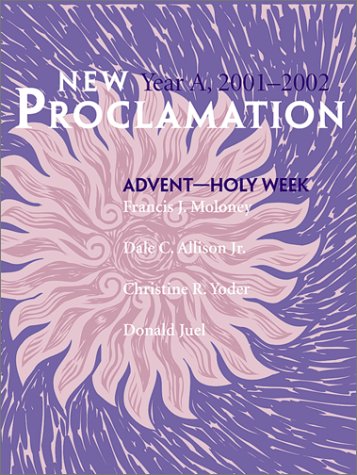New Proclamation: Year A, Advent Through Holy Week, 2001-2002 (New Proclamation Series) - Softcover

Reader-friendly workbook design for easy note-taking and lay-flat binding for hands-free usage ·
Poetry, literature, and narrative highlight dimensions of the liturgical season and day ·
Discusses the present-day cultural context as it relates to the biblical texts.
"synopsis" may belong to another edition of this title.
Francis J. Moloney, S.D.B., is Professor of New Testament at Catholic University of America, Washington, D.C., and the author of Fortress’ three-volume commentary on the Gospel of John.
Dale C. Allison Jr. is Professor of New Testament at Pittsburgh Theological Seminary and the author of Jesus of Nazareth: Millenarian Prophet (Fortress Press, 1998).
Christine R. Yoder is Professor of Old Testament at Columbia Theological Seminary, Decatur, Ga.
Donald H. Juel is Richard J. Dearborn Professor of New Testament Theology at Princeton Theological Seminary, Princeton, N.J., and the author of Fortress’ A Master of Surprise: Mark Interpreted.
The history of the liturgical cycle works back from the celebration of the end of Jesus’ life to its beginning. But the church’s year tells a narrative of the saving work of God in and through Jesus by working chronologically through his life-story and beyond. The mystery of Christ is unfolded from the Incarnation and the Epiphany to his Passing Over in death and resurrection, Ascension, and Pentecost. From that point on, the “Ordinary” weeks of the year begin their rhythmic numbering as the liturgical year circles back again to Advent, the celebration of the expectation of the coming of the Lord.
There is evidence from the fourth century of a number of different ways of celebrating a preparation for Christmas and Epiphany. One element united these early forms of what eventually came to be called Advent; they were not to be identified with Lent. Advent was not a time of penance for Christians accompanying those to be new members through Baptism at Easter. The “birth” of new life within the Christian community, so much a part of the celebration of the new creation that took place in the death and resurrection of Jesus, was not the feature of Christmas and the Epiphany. Looking back across the human story, especially as it is recorded in the Bible, the early church saw that humankind had waited long for the coming of the Savior. The celebration of Advent was to be associated with the experience of waiting. Advent played a more psychological role in the life of the Christian community, waiting in eager expectation for the coming of the Lord.
This understanding of Advent as a period different from Lent determined the eventual establishment of the season in the Roman church. It was Pope Gregory the Great (591–604) who established the four Sundays in Advent, a move deliberately calculated to indicate the difference between this season of preparation for Christmas and the six Sundays of Lent that prepare for Easter. Closely linked with this establishment of Advent as a distinct period of the Christian year was the development of a celebration of Christmas as a feast with a character of its own, distinguished from the celebration of Epiphany. The emergence of the season of Advent, directed specifically toward the preparation of the faithful for the celebration of the coming of the Lord at Christmas enabled the gradual development of an Advent liturgy.
Advent, in many ways, catches a fundamental element of Christian life. It is a season that waits as Christians prepare for the celebration of the remembering of Christ’s first coming. It does so, however, by focusing the attention of the believer on the need to direct the mind and the heart to await Christ’s second coming at the end of time. The liturgy of Advent, perhaps more than any other liturgical season, reminds the believing individual and community that they are living in an in-between-time: the time between Jesus’ first coming and Jesus’ final return. Advent celebrates the tension between the now and the not yet, the givenness of all that God has done for us in and through the life and teaching, death and resurrection of Jesus (the first coming), and the fullness of life, yet to come (the second coming). The Christ-event extends across these two “comings.” One has already taken place: “I am bringing you good news of great joy for all the people: to you is born this day in the city of David a Savior, who is the Messiah, the Lord” (Luke 2:10-11). Another lies at some time in the future: “Then they will see ‘the Son of Man coming in clouds’ with great power and glory. Then he will send out the angels and gather his elect from the four winds, from the ends of the earth to the ends of heaven. . . .But about that day or hour no one knows, neither the angels in heaven nor the Son, but only the Father” (Mark 13:26-27, 32).
"About this title" may belong to another edition of this title.
- PublisherFortress Press
- Publication date2001
- ISBN 10 0800642457
- ISBN 13 9780800642457
- BindingPaperback
- Number of pages242
- EditorMoloney Francis J.
Buy New
Learn more about this copy
Shipping:
US$ 4.00
Within U.S.A.
Top Search Results from the AbeBooks Marketplace
New Proclamation: Year A, Advent Through Holy Week, 2001-2002 (New Proclamation Series)
Book Description Paperback. Condition: new. New. Fast Shipping and good customer service. Seller Inventory # Holz_New_0800642457
New Proclamation: Year A, Advent Through Holy Week, 2001-2002 (New Proclamation Series)
Book Description Paperback. Condition: new. New Copy. Customer Service Guaranteed. Seller Inventory # think0800642457
New Proclamation: Year A, Advent Through Holy Week, 2001-2002 (New Proclamation Series)
Book Description Paperback. Condition: new. New. Seller Inventory # Wizard0800642457

